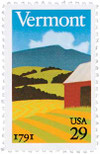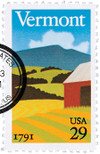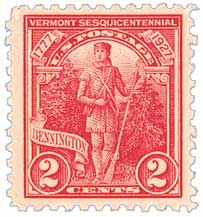
# 2533 - 1991 29c Vermont Statehood
US #2533
1991 Vermont Statehood
- Marks the 200th anniversary of Vermont’s statehood
Category of Stamp: Commemorative
Value: 29¢, First Class mail rate
First Day of Issue: March 1, 1991
First Day City: Bennington, Vermont
Quantity Issued: 179,990,000
Printed by: American Bank Note Company
Printing Method: photogravure
Format: Panes of 50, from printing cylinders of 200 (10 across, 20 down)
Perforations: 11
Reason the stamp was issued: This stamp was issued in honor of the 200th anniversary of Vermont entering the Union. It was the first state after the original 13 to become part of the US. The 29¢ stamp reflects an increase in the First-Class mail rate.
About the stamp design: Vermont artist Sabra Field was chosen to create the artwork for the stamp honoring her home state. She specializes in woodcut prints. The image portrays a Vermont farm scene, with the red hay barn and rows of cut hay waiting to be baled. The Green Mountains are in the background.
First Day City: The Vermont Statehood stamp was dedicated in a ceremony on the campus of Bennington College.
Vermont Becomes 14th State
Vermont served mainly as a hunting ground for the tribes of Algonquian Indians before white settlement. France's Samuel de Champlain was one of the first Europeans to explore the Vermont area. He reached Lake Champlain, which bears his name, in 1609.
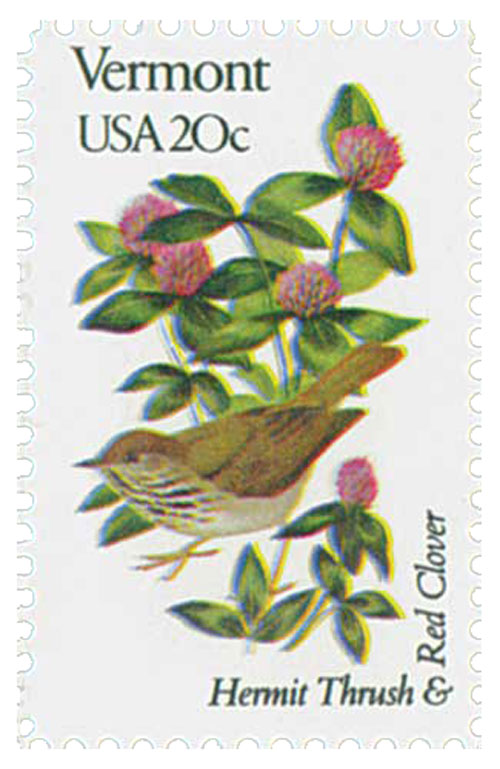
Champlain claimed all of the area that is Vermont for France. In 1666, the French built a fort on Isle La Motte in Lake Champlain. The English built a fort at Chimney Point, west of today's Middlebury, in 1690. However, the first permanent settlement was Fort Dummer, which is near today's Brattleboro, and was built by colonists from Massachusetts in 1724. This fort was needed to protect western Massachusetts from attacks by the French and Indians. Vermont was a battleground during the French and Indian War (1754-1763). The war resulted in England's control of most of North America, including Vermont.
The royal governors of New Hampshire and New York both made land grants to settlers in the Vermont area. Unfortunately, their claims often overlapped. In 1764, England ruled that the claims made by New York were legitimate, and ordered settlers with New Hampshire grants either to pay New York or leave. This resulted in the formation of the Green Mountain Boys, a military force organized to protect land claims granted by New Hampshire. The Green Mountain Boys drove the New York settlers from Vermont.
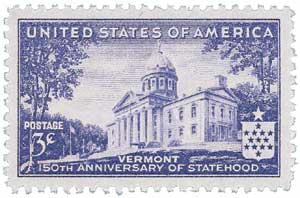
Vermont provided many soldiers in the fight against the British during the American Revolution (1775-1783). In May 1775, Ethan Allen, Benedict Arnold, and a force of more than 80 Green Mountain Boys took Fort Ticonderoga from the British, which was located in New York on Lake Champlain. Colonial troops held the fort until 1777. When the patriots were driven from the fort, the British pursued. A rear guard action commanded by Seth Warner delayed the British long enough for the patriots to escape. Although the Battle of Bennington, fought on August 16, 1777, is associated with Vermont, it took place in New York. The Battle of Bennington and the surrender at Yorktown ended British occupation of the northern colonies.
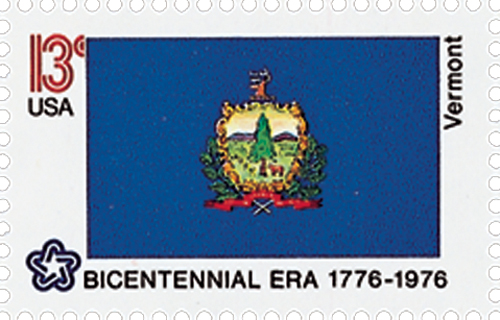
As the Revolutionary War continued, the land disputes involving Vermont, New York, and New Hampshire remained unresolved. On January 15, 1777, Vermont settlers declared the area an independent republic named New Connecticut. In July 1777, Vermont adopted its first constitution and took its present name, which is taken from the French vert mont, or "green mountain." In 1783, George Washington wrote that he believed it would take force to end Vermont's independence. However, no efforts were ever made to do so.
In 1790, Vermont paid New York $30,000 to resolve its land claims and New Hampshire relinquished its claims in Vermont. As a result, Vermont joined the Union on March 4, 1791, and was the first state admitted to the Union after the 13 original colonies.
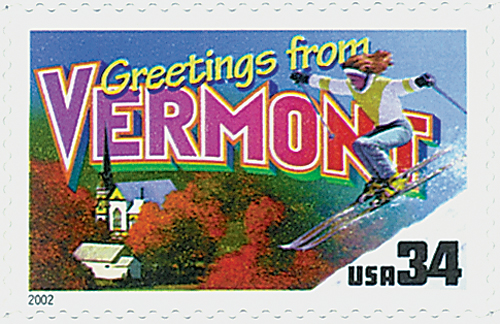
Vermonters fought the British during the War of 1812 in the battles of Chippewa, Lundy's Lane, and Plattsburgh. Yet, the war was very unpopular in Vermont, as the state depended on trade with the British colony of Canada. The end of the war marked the start of a period of economic decline. In fact, when the economy revived from 1823-36, many people left the state, afraid that recession would return. These people moved to better farmland in the Midwest or took factory jobs in cities in other states.
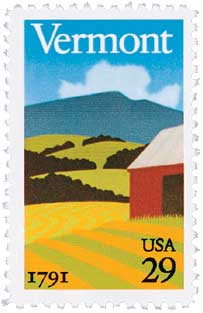
The completion of the Champlain Canal in 1823 allowed the state's farmers to find markets for their products. The canal linked with Lake Champlain and New York's Hudson River. This meant farm products could be sent quickly to New York City. The market for wool was especially lucrative. By 1840, Vermont had six sheep for every person in the state. Soon after, competition from Midwestern farmers caused wool prices to drop. Vermont farmers sold their sheep for meat, and by 1860, the sheep population had been cut in half. This crisis forced Vermont to become a dairy-farming state. Farming became even less profitable after the Civil War. Large numbers of farmers left the state for factory work or to claim land in the Midwest. However, French Canadians and European immigrants continued to move to Vermont's cities. During the late 1800s, Vermont's wood-processing and cheese-making industries began to flourish.
US #2533
1991 Vermont Statehood
- Marks the 200th anniversary of Vermont’s statehood
Category of Stamp: Commemorative
Value: 29¢, First Class mail rate
First Day of Issue: March 1, 1991
First Day City: Bennington, Vermont
Quantity Issued: 179,990,000
Printed by: American Bank Note Company
Printing Method: photogravure
Format: Panes of 50, from printing cylinders of 200 (10 across, 20 down)
Perforations: 11
Reason the stamp was issued: This stamp was issued in honor of the 200th anniversary of Vermont entering the Union. It was the first state after the original 13 to become part of the US. The 29¢ stamp reflects an increase in the First-Class mail rate.
About the stamp design: Vermont artist Sabra Field was chosen to create the artwork for the stamp honoring her home state. She specializes in woodcut prints. The image portrays a Vermont farm scene, with the red hay barn and rows of cut hay waiting to be baled. The Green Mountains are in the background.
First Day City: The Vermont Statehood stamp was dedicated in a ceremony on the campus of Bennington College.
Vermont Becomes 14th State
Vermont served mainly as a hunting ground for the tribes of Algonquian Indians before white settlement. France's Samuel de Champlain was one of the first Europeans to explore the Vermont area. He reached Lake Champlain, which bears his name, in 1609.

Champlain claimed all of the area that is Vermont for France. In 1666, the French built a fort on Isle La Motte in Lake Champlain. The English built a fort at Chimney Point, west of today's Middlebury, in 1690. However, the first permanent settlement was Fort Dummer, which is near today's Brattleboro, and was built by colonists from Massachusetts in 1724. This fort was needed to protect western Massachusetts from attacks by the French and Indians. Vermont was a battleground during the French and Indian War (1754-1763). The war resulted in England's control of most of North America, including Vermont.
The royal governors of New Hampshire and New York both made land grants to settlers in the Vermont area. Unfortunately, their claims often overlapped. In 1764, England ruled that the claims made by New York were legitimate, and ordered settlers with New Hampshire grants either to pay New York or leave. This resulted in the formation of the Green Mountain Boys, a military force organized to protect land claims granted by New Hampshire. The Green Mountain Boys drove the New York settlers from Vermont.

Vermont provided many soldiers in the fight against the British during the American Revolution (1775-1783). In May 1775, Ethan Allen, Benedict Arnold, and a force of more than 80 Green Mountain Boys took Fort Ticonderoga from the British, which was located in New York on Lake Champlain. Colonial troops held the fort until 1777. When the patriots were driven from the fort, the British pursued. A rear guard action commanded by Seth Warner delayed the British long enough for the patriots to escape. Although the Battle of Bennington, fought on August 16, 1777, is associated with Vermont, it took place in New York. The Battle of Bennington and the surrender at Yorktown ended British occupation of the northern colonies.

As the Revolutionary War continued, the land disputes involving Vermont, New York, and New Hampshire remained unresolved. On January 15, 1777, Vermont settlers declared the area an independent republic named New Connecticut. In July 1777, Vermont adopted its first constitution and took its present name, which is taken from the French vert mont, or "green mountain." In 1783, George Washington wrote that he believed it would take force to end Vermont's independence. However, no efforts were ever made to do so.
In 1790, Vermont paid New York $30,000 to resolve its land claims and New Hampshire relinquished its claims in Vermont. As a result, Vermont joined the Union on March 4, 1791, and was the first state admitted to the Union after the 13 original colonies.

Vermonters fought the British during the War of 1812 in the battles of Chippewa, Lundy's Lane, and Plattsburgh. Yet, the war was very unpopular in Vermont, as the state depended on trade with the British colony of Canada. The end of the war marked the start of a period of economic decline. In fact, when the economy revived from 1823-36, many people left the state, afraid that recession would return. These people moved to better farmland in the Midwest or took factory jobs in cities in other states.

The completion of the Champlain Canal in 1823 allowed the state's farmers to find markets for their products. The canal linked with Lake Champlain and New York's Hudson River. This meant farm products could be sent quickly to New York City. The market for wool was especially lucrative. By 1840, Vermont had six sheep for every person in the state. Soon after, competition from Midwestern farmers caused wool prices to drop. Vermont farmers sold their sheep for meat, and by 1860, the sheep population had been cut in half. This crisis forced Vermont to become a dairy-farming state. Farming became even less profitable after the Civil War. Large numbers of farmers left the state for factory work or to claim land in the Midwest. However, French Canadians and European immigrants continued to move to Vermont's cities. During the late 1800s, Vermont's wood-processing and cheese-making industries began to flourish.








